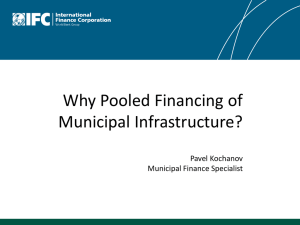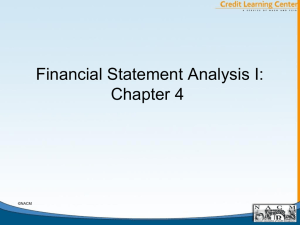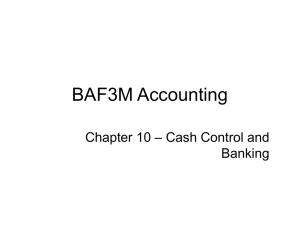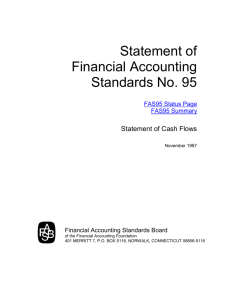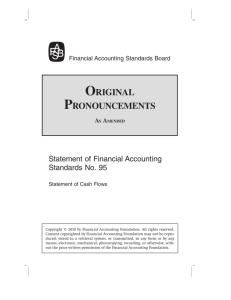Cash flow statement - entelectonline.co.za
advertisement
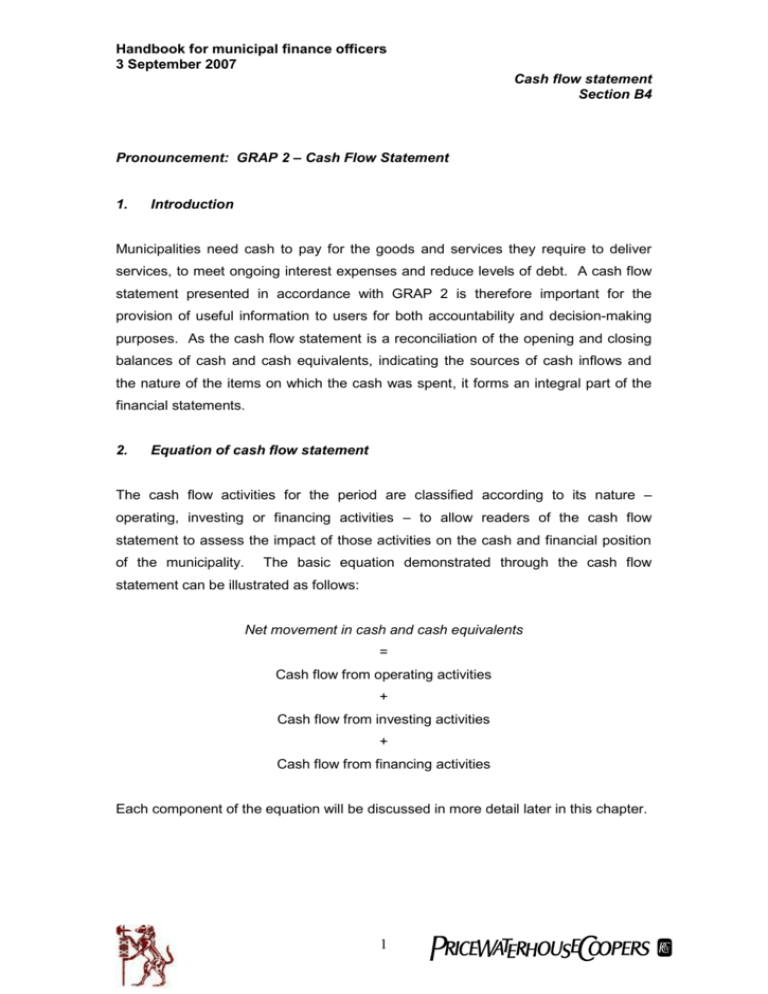
Handbook for municipal finance officers 3 September 2007 Cash flow statement Section B4 Pronouncement: GRAP 2 – Cash Flow Statement 1. Introduction Municipalities need cash to pay for the goods and services they require to deliver services, to meet ongoing interest expenses and reduce levels of debt. A cash flow statement presented in accordance with GRAP 2 is therefore important for the provision of useful information to users for both accountability and decision-making purposes. As the cash flow statement is a reconciliation of the opening and closing balances of cash and cash equivalents, indicating the sources of cash inflows and the nature of the items on which the cash was spent, it forms an integral part of the financial statements. 2. Equation of cash flow statement The cash flow activities for the period are classified according to its nature – operating, investing or financing activities – to allow readers of the cash flow statement to assess the impact of those activities on the cash and financial position of the municipality. The basic equation demonstrated through the cash flow statement can be illustrated as follows: Net movement in cash and cash equivalents = Cash flow from operating activities + Cash flow from investing activities + Cash flow from financing activities Each component of the equation will be discussed in more detail later in this chapter. 1 Handbook for municipal finance officers 3 September 2007 Cash flow statement Section B4 2. Preparing a cash flow statement When preparing a cash flow statement all the transactions that were debited and credited to the bank account during the year should be identified. This can be done by using one of the following methods: 2.1 Analysing the bank account (cash book) in the general ledger One can attempt to summarise all the transactions recorded in the cash book into the line-items needed for the cash flow statement, but it should be clear that this method is inefficient and impractical although this will be the most accurate, the time and effort will not be justifiable as all cash transactions will need to be analysed and classified. 2.2 Analysing the statement of financial position Every transaction that occurs will affect either the assets and/or the liabilities of the municipality. In identifying all the transactions that occurred during the year, the starting point would be calculating the movement in the line-items of the statement of financial position. The purpose is to reconstruct the movements in each line-item to identify transactions for which the cash book represents the contra entry. 3. Cash and cash equivalents The amounts to be included in this classification are all cash on hand and demand deposits. No guidance is given in GRAP 2 for a demand deposit. However these are generally accepted to be deposits with financial institutions that are repayable on demand and available within 24 hours, or one working day, without penalty. Demand deposits therefore, will include accounts where additional funds may be deposited at any time and funds withdrawn at any time without prior notice, for example a bank current account. 2 Handbook for municipal finance officers 3 September 2007 Cash flow statement Section B4 Cash and cash equivalents are defined as short term highly liquid investments that are readily convertible to known amounts of cash and which are subject to an insignificant risk of changes in value. In order to meet the definition of cash equivalents an investment will normally have to have a “short maturity”. A short maturity would be a period of three months or less from the date of acquisition of the investment. The use of a short maturity period when considering investments as cash equivalents incorporates the fact that the investments should be so near to cash that there is insignificant risk of change in value. Bank overdrafts that are repayable on demand are included as a component of cash and cash equivalents. Transfers or movements between bank accounts (or cash resources) are not separately accounted for in the cash flow statements as they do not represent an inflow or outflow of cash. GRAP 2.45 requires an entity to disclose the policy that it adopts in determining the composition of its cash equivalents. Any change in that policy is regarded as a change in accounting policy and should be accounted for in accordance with GRAP 3 Accounting Policies, Changes in Accounting Estimates and Errors. [GRAP 2.46] Example 4.01 – Cash and cash equivalents Accounting policy Cash and cash equivalents For the purpose of the Municipalities Cash Flow Statement cash and cash equivalents at 30 June comprise cash at bank and in hand net of bank overdrafts. 3 Handbook for municipal finance officers 3 September 2007 Cash flow statement Section B4 Extract from the notes to the financial statements Cash and cash equivalents 20x5 R Bank balances Cash at hand For the purpose of the cash flow statement, the cash and cash equivalents comprise the following Cash and bank balances Bank overdraft 4. 20x6 R 72 537 4 453 76 990 85 673 6 090 91 763 76 990 (850) 76 140 91 763 (4 300) 87 463 Operating activities Operating activities represent the main cash-generating activities of a municipality, e.g. property rates, services charges, payments to and on behalf of employees, payments for goods and services. Therefore, cash flows from operating activities represent the cash effect of transactions and items included in calculating the surplus or deficit for the year. Cash generated from (or utilised in) the operating activities of a municipality indicates the extent to which the operating activities have generated or utilised cash flows to sustain the operating capacity whilst repaying existing loans (financing activities) and making additional investments in infrastructure (investing activities), without depending on external financing. The cash generated by operations is calculated as the difference between cash received from consumers and government and cash paid to suppliers and employees. These two amounts are not disclosed as such in the statement of financial performance, (as the Statement of Financial Performance is prepared on the accrual basis of accounting) and are calculated by adjusting total revenue and expenses for non-cash items, changes in working capital and other items that are either presented separately classified as investing or financing activities. 4 Handbook for municipal finance officers 3 September 2007 Cash flow statement Section B4 Cash flows from operating activities are primarily derived from the principal cashgenerating activities of the entity. Examples of cash flows from operating activities are: a) cash receipts from taxes, levies and fines; b) cash receipts from charges for goods and services provided by the entity; c) cash receipts from grants or transfers and other appropriations or other budget authority made by national government or other entities; d) cash receipts from royalties, fees, commissions and other revenue; e) cash payments to other entities to finance their operations (not including loans); f) cash payments to suppliers for goods and services; g) cash payments to and on behalf of employees; h) cash receipts and cash payments of an insurance entity for premiums and claims, annuities and other policy benefits; i) cash payments of local property taxes or income taxes (where appropriate) in relation to operating activities; j) cash receipts and payments from contracts held for dealing or trading purposes; k) cash receipts or payments from discontinuing operations; and l) cash receipts or payments in relation to litigation settlements. Example 4.02 – Cash flows from operating activities Extract from the cash flow statements 20x5 R Cash flows from operating activities Cash received from consumers and government Cash paid to suppliers and employees Cash generated by operations Interest paid Interest received Dividends received 63 811 385 (55 311 047) 8 500 371 (2 273 908) 4 962 915 186 500 Dividends paid may be classified as a financing cash flow because they are a cost of obtaining financial resources. Alternatively, dividends paid may be classified as a component of cash flows from operating activities in order to assist users to determine the ability of an entity to make these payments out of operating cash flows. 5 Handbook for municipal finance officers 3 September 2007 Cash flow statement Section B4 a) Cash received from consumers and government Every revenue transaction recognised in the statement of financial performance has been “earned” during the year either by providing services or through grants, donations and subsidies. In accordance with GAMAP 9 revenue is recognised regardless of whether cash payment has been received. Cash receipts from consumers and government will be a result of a combination of the following events: receipt of cash for revenue recognised in the previous financial year (recovering of debtors); receipt of cash for revenue recognised in the current financial year (operational grants, etc) and/or receipt of cash for revenue that will only be recognised during the next financial year (pre-payments). Example 4.03 – Cash received from consumers and government This example illustrates the determination of the amounts received from consumers and government from the information disclosed in the Statement of Financial Performance. 20x5 R Cash received from consumers and government Total revenue (taken from the statement of performance) Adjusted for non-cash items - Gains on disposal of property, plant and equipment Adjusted for items presented separately disclosed: - Dividends received - Interest received Adjusted for changes in working capital - Increase in consumer debtors * - Increase in other debtors * financial 73 907 942 (124 794) (186 500) (4 962 915) (2 783 033) (2 039 315) 63 811 385 It is assumed that ‘bad debts’ in the statement of financial performance represent bad debts written-off as well as contribution to the provision for doubtful debts. Bad debts 6 Handbook for municipal finance officers 3 September 2007 Cash flow statement Section B4 is a non-cash adjustment to the closing balance of consumer debtors therefore it should be added before calculating the movement for the year. The movement in debtors (consumer and other debtors) is calculated by adding the opening balance of debtors and deducting the closing balance. b) Cash paid to suppliers and employees The cash paid to suppliers and employees forms part of the expenses paid during the year and is calculated from all the expenses recognised in the statement of financial performance. Similarly to cash receipts, the expenses recognised in the financial statements were incurred during the year and not necessarily paid for in cash. Cash paid to suppliers and employees is calculated as a combination of the following: payments for expenses recognised during the previous financial year (e.g. creditors); payment for expenses recognised during the current financial year (e.g. salaries), and payments for expenses that will only be recognised during the next financial year (e.g. payments in advance). Example 4.04 – Cash paid to suppliers and employees This example illustrates the determination of the amount paid to suppliers and employees from the information disclosed in the Statement of Financial Performance and Statement of Financial Position. The movement in inventory is calculated by adding the opening balance and deducting the closing balance, whereas the movement in current liabilities is calculated by adding the closing balance and deducting the opening balance. 7 Handbook for municipal finance officers 3 September 2007 Cash flow statement Section B4 Total expenditure Adjusted for non-cash items: - Depreciation - Contribution to current provisions - Contribution to non-current provisions - Contribution to bad debts provision - Bad debts Adjusted for items presented separately disclosed: - Interest paid Adjusted for changes in working capital: - Increase in creditors - Increase in consumer deposits - Decrease in unspent conditional grants - Increase in VAT payable - Decrease in inventory Cash paid to suppliers and employees c) R 66 276 686 (4 377 480) (24 832) (75 585) (20 879) (1 072 377) (2 273 908 ) (3 157 497) (18 177) 116 658 (7 892) (53 703) 55 311 014 Cash generated by operations A municipality is required to report cash flow from operating activities using the direct method, whereby major classes of gross cash receipts (e.g. cash collected from customers) and gross cash payments (e.g. cash paid to suppliers and employees) disclosed. These gross operating cash flows are aggregated to produce the net operating cash flow of the municipality. Cash generated by operations can be seen as the cash equivalent to the surplus/deficit for the year. The reconciliation between the surplus/deficit and the cash generated by operations are disclosed as a note to the financial statements, indicating the following adjustments made to the surplus/deficit: reversal of items that are disclosed separately on the face of the cash flow statement e.g. interest received and interest paid; eliminating all non-cash transactions; and movement in working capital, e.g. inventories, debtors, creditors, etc. This reconciliation allows the users to assess the quality of the surplus and ability of the municipality to transform accounting surpluses into cash 8 Handbook for municipal finance officers 3 September 2007 Cash flow statement Section B4 demonstrating to the user why the surplus has not resulted in an equal amount of cash. The reconciliation of profit or loss to net cash flows from operating activities will disclose movements in inventory, accounts receivable and accounts payable related to operating activities, other non-cash items (e.g. depreciation, provisions and gain or loss on sale of assets) and other items, such as interest and taxation, which are required to be shown separately. For the reconciliation to properly carried out, it will be necessary to analyse the movements in opening and closing accounts receivable and payable in order to eliminate those movements that relate to items reported in financing or investing activities, for example purchasing a fixed asset prior to the year end on credit. In this situation, the closing creditors balance would need to be adjusted to eliminate the amount owing for the fixed asset purchase before working out the balance sheet movements for operating creditors. Example 4.05 – Cash generated by operations This example illustrates the reconciliation of the surplus for the year to the net cash flow from operating activities. Surplus for the year Adjusted for non-cash items - Depreciation - Contribution to current provisions - Contribution to non-current provisions - Contribution to bad debts provision - Gains on disposal of property, plant and equipment - Equity accounted share of associate’s surplus - Bad debts Adjusted for items presented separately - Dividends received - Interest received - Interest paid Adjusted for changes in working capital - Increase in gross consumer debtors - Increase in other debtors - Increase in creditors - Increase in consumer deposits 9 R 7 640 256 4 377 480 24 832 75 585 20 879 (124 794) (9 000) 1 072 377 (186 500) (4 962 915) 2 273 908 (2 783 033) (2 039 315) 3 157 497 18 177 Handbook for municipal finance officers 3 September 2007 Cash flow statement Section B4 - Decrease in unspent conditional grants - Increase in VAT payable - Decrease in inventory - Income taxes paid Cash flows from operating activities d) (116 658) 7 892 53 703 0 8 500 371 Interest and dividends Cash flows from interest paid and interest and dividends received are disclosed separately on the face of the cash flow statement and can be classified as either operating, investing or financing activities, depending on a decision by management. The classification should however be applied consistently from one period to the next. e) Taxes on surplus Cash flows arising from income tax are classified as operating activities and are also disclosed separately on the face of the cash flow statement. 5. Investing activities Investing activities represent investments made in infrastructure and other noncurrent assets which are intended to contribute to the delivering of services in future. Amongst others, the following examples of investing activities are listed in GRAP 2: Cash payments to acquire or construct property, plant and equipment and other non-current assets. Cash receipts (proceeds) from the sale of non-current assets. Cash advances/loans made to other parties. Cash receipts for the repayment of advances/loans made to other parties. It should be noted that not all movements in non-current assets will result in cash flows. Revaluations, impairment and depreciation are non-cash events and should be excluded from the calculations. 10 Handbook for municipal finance officers 3 September 2007 Cash flow statement Section B4 6. Financing activities Cash flows from financing activities are an indication of the size and composition of the contributed capital and borrowings of the entity. Therefore, cash flows from financing activities generally comprise receipts or payments in relation to the obtaining, servicing and repayment or redemption of debt and equity sources of finance. Separate disclosure of the cash flows from financing activities is useful for the users of the financial statements when determining the manner in which operating and investing activities are being financed. The examples provided in GRAP 2.15 are: cash proceeds from issuing debentures, loans, notes, bonds, mortgages and other short- or long-term borrowings; cash repayments of amounts borrowed; and cash payments by a lessee for the reduction of the outstanding liability relating to a finance lease. Finance lease instalments consist of a capital and interest portion. The interest portion is classified as operating activities, while the capital portion is classified as financing activities. 7. Reporting on a net basis Cash receipts and payments for operating, investing and financing activities are presented separately and may not be presented on a net basis, except where the cash receipts and payments were made on behalf of another party and the cash flows rather represent the activities of the other entity, e.g. receipt and payment of VAT and licence fees. 8. Investments in controlled entities, associates and joint ventures When an interest in a controlled entity is acquired or disposed of, only the resultant cash flows are reflected as part of investing activities. 11 Information about the Handbook for municipal finance officers 3 September 2007 Cash flow statement Section B4 underlying assets and liabilities acquired or disposed of are provided by means of a note. When the equity or cost method of accounting is applied to an investment, the cash flow reported in the cash flow statement is limited to the actual cash flow between the municipality and the entity such as dividends received or advance made. Where the proportionate consolidation method is applied to account for the municipality’s interest in a joint venture, the municipality includes its proportionate share of the jointly controlled entity’s cash flows. 9. Non-cash transactions and events In some instances, investing and financing activities do not involve the flow of cash but the asset and liability complement of the municipality has been affected, e.g. when a financial lease is initially entered into, there is usually no flow of cash, although a new asset has been acquired as well as a new liability raised. These transactions are excluded from the cash flow statement. 10. Comprehensive illustration of a cash flow statement Accounting policy Cash and Cash Equivalents Cash includes cash on hand and cash with banks. Cash equivalents are short-term highly liquid investments that are held with registered banking institutions with maturities of three months or less and are subject to an insignificant risk of change in value. For the purposes of the cash flow statement, cash and cash equivalents comprise cash on hand, deposits held on call with banks and investments in financial instruments, net of bank overdrafts. Bank overdrafts are recorded based on the facility utilised. overdraft are expensed as incurred. 12 Finance charges on bank Handbook for municipal finance officers 3 September 2007 Cash flow statement Section B4 Cash flow statement for the year ended 30 June 20x6 Note R Cash flow from operating activities Cash received from consumers, government and other Cash paid to suppliers and employees 1 2 63 811 385 55 311 014 Cash generated from operating activities Dividends received Interest received Interest paid 3 8 500 371 186 500 4 962 915 (2 273 908) Net cash flow from operating activities 11 375 878 Cash flow from investing activities Additions to property, plant and equipment Proceeds on disposal of property, plant and equipment Additions to investment property Increase in investments Increase in non-current receivables Decrease in call investment deposits 4 Net cash flow from investing activities (9 587 473) 374 100 (150 000) (4 765 332) (1 909 085) 3 464 275 (12 573 515) Cash flow from financing activities Non-current liabilities raised Decrease in short-term loans 1 056 204 (50 000) Net cash flow from financing activities 1 006 204 Net cash flows for the year Cash and cash equivalents beginning of year Cash and cash equivalents end of year (191 433) (6 347 478) 3 13 (6 538 911) Handbook for municipal finance officers 3 September 2007 Cash flow statement Section B4 Notes 2. Proceeds from disposal of property, plant and equipment Carrying value of disposals Gain on disposal of property, plant and equipment 249 306 124 794 Proceeds from disposal of property, plant and equipment 374 100 3. Cash and cash equivalents Bank balances and cash Bank overdraft 2 631 (6 541 542) 3 487 (6 350 965) Total cash and cash equivalents (6 538 911) (6 347 478) 14


